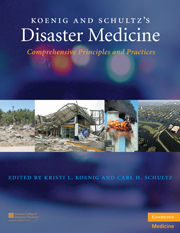Book contents
- Frontmatter
- Contents
- List of Contributors
- Contributor Biographies
- Foreword
- Preface
- Acknowledgments
- PART I CONCEPTUAL FRAMEWORK AND STRATEGIC OVERVIEW
- PART II OPERATIONAL ISSUES
- 9 Public Health and Emergency Management Systems
- 10 Legislative Authorities and Regulatory Issues
- 11 Syndromic Surveillance
- 12 Triage
- 13 Personal Protective Equipment
- 14 Decontamination
- 15 Quarantine
- 16 Mass Dispensing of Antibiotics and Vaccines
- 17 Management of Mass Gatherings
- 18 Transportation Disasters
- 19 Emergency Medical Services Scene Management
- 20 Healthcare Facility Disaster Management
- 21 Mass Fatality Management
- 22 Crisis and Emergency Risk Communication
- 23 Telemedicine and Telehealth Role in Public Health Emergencies
- 24 Complex Public Health Emergencies
- 25 Patient Identification and Tracking
- PART III CLINICAL MANAGEMENT
- Index
- Plate section
- References
20 - Healthcare Facility Disaster Management
from PART II - OPERATIONAL ISSUES
Published online by Cambridge University Press: 05 August 2011
- Frontmatter
- Contents
- List of Contributors
- Contributor Biographies
- Foreword
- Preface
- Acknowledgments
- PART I CONCEPTUAL FRAMEWORK AND STRATEGIC OVERVIEW
- PART II OPERATIONAL ISSUES
- 9 Public Health and Emergency Management Systems
- 10 Legislative Authorities and Regulatory Issues
- 11 Syndromic Surveillance
- 12 Triage
- 13 Personal Protective Equipment
- 14 Decontamination
- 15 Quarantine
- 16 Mass Dispensing of Antibiotics and Vaccines
- 17 Management of Mass Gatherings
- 18 Transportation Disasters
- 19 Emergency Medical Services Scene Management
- 20 Healthcare Facility Disaster Management
- 21 Mass Fatality Management
- 22 Crisis and Emergency Risk Communication
- 23 Telemedicine and Telehealth Role in Public Health Emergencies
- 24 Complex Public Health Emergencies
- 25 Patient Identification and Tracking
- PART III CLINICAL MANAGEMENT
- Index
- Plate section
- References
Summary
OVERVIEW
Disaster preparedness in healthcare facilities has historically been a low priority and is often viewed as a chore or unnecessary mandate. Too often it has not received the support of top management in a meaningful way. In some societies, healthcare is viewed as a right, with the expectation that the hospital be ready 24/7 to render care as needed. Lawyers may sue the unprepared hospital or healthcare professional after a disaster in some cultures. In past decades, many healthcare professional training programs, including those in the U.S., have not emphasized disaster preparedness in their curricula. Even residencies in emergency medicine sometimes neglect this important subject. Since the terrorist attacks of September 11, 2001 in the U.S., many healthcare training programs have begun educating students on this vital topic and its implications for their communities. Many hospitals have experienced a resurgence of interest in preparedness and have hired full-time emergency management personnel. In contrast, other institutions have only prepared minimally as required by outside entities (e.g., the local or national health authority or The Joint Commission in the U.S.). Hospital preparedness efforts have waxed and waned over the years, and the tempo of preparedness planning, training, and drilling has vacillated depending on national or local requirements or trends and real-world events. Because students in hospital and healthcare administration usually receive no training on this management topic, they are not fully cognizant of the possible demands that could be placed on them and their facility during a disaster or emergency situation.
Keywords
- Type
- Chapter
- Information
- Koenig and Schultz's Disaster MedicineComprehensive Principles and Practices, pp. 285 - 311Publisher: Cambridge University PressPrint publication year: 2009



